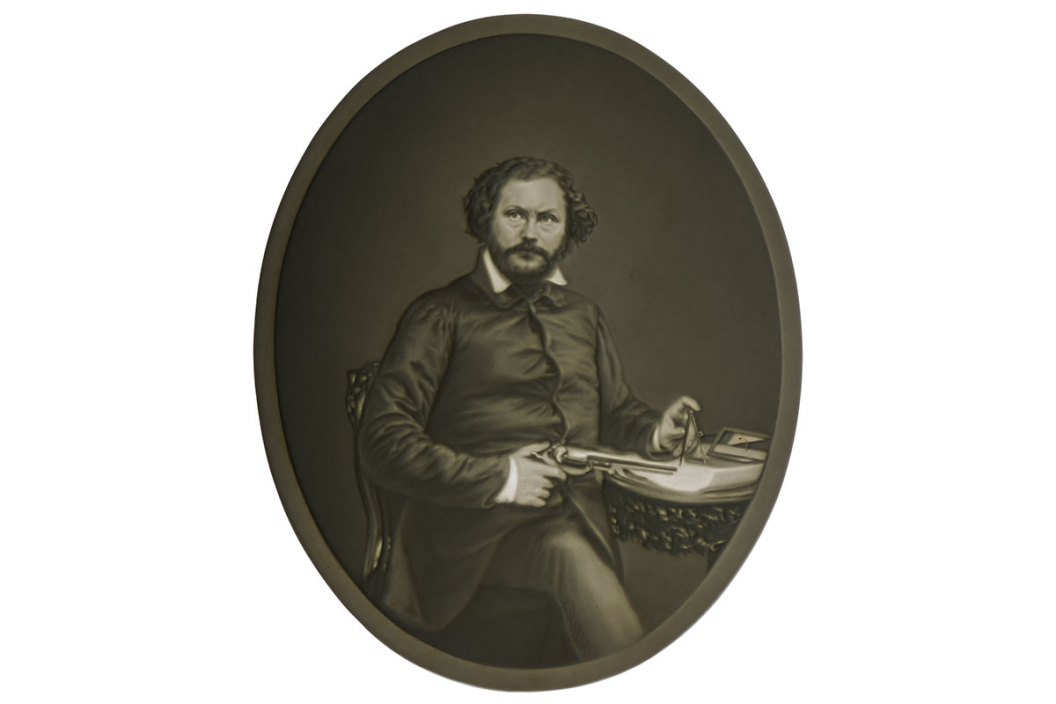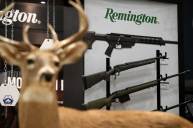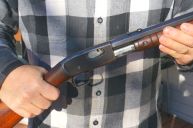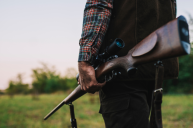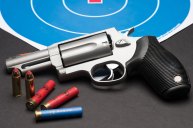Samuel Colt, one of history's most famous gun designers, never even saw his company's most famous gun.
To know the story of Samuel Colt is to know the story of gun innovation. Specifically, it was the innovation that changed much of what the world thought it knew about firearms.
Samuel Colt's name will forever be synonymous with small arms—specifically revolvers. But part of the story involves another firearm that made a huge impact on society.
Depending on who you talk to, the term "Gun That Won The West" can apply to either the Winchester 1873 lever action rifle, or the Colt Single Action Army revolver, also known as the Colt Peacemaker.
Regardless, the sentiment means the same thing: both the SAA and the '73 were repeating firearms that were rugged, simple, and versatile while representing the peak of 19th century gun technology.
When both guns were carried together and chambered for the same cartridge, they were capable of everything from mid-range hunting and defense to up-close encounters. This capability allowed frontiersmen to literally gain a foothold and tame the Wild West.
What many people don't realize is that Samuel Colt died well before the famous Peacemaker was ever made. It stood on the shoulders of Colt's previous revolver designs, but he didn't directly have much to do with the design of the SAA.
Therein lies perhaps the most tragic part of the life Samuel Colt lived. We'll zoom in on that life, and shed some light on how the Single Action Army revolver earned a share of that vaunted nickname.
Samuel Colt's Early Life
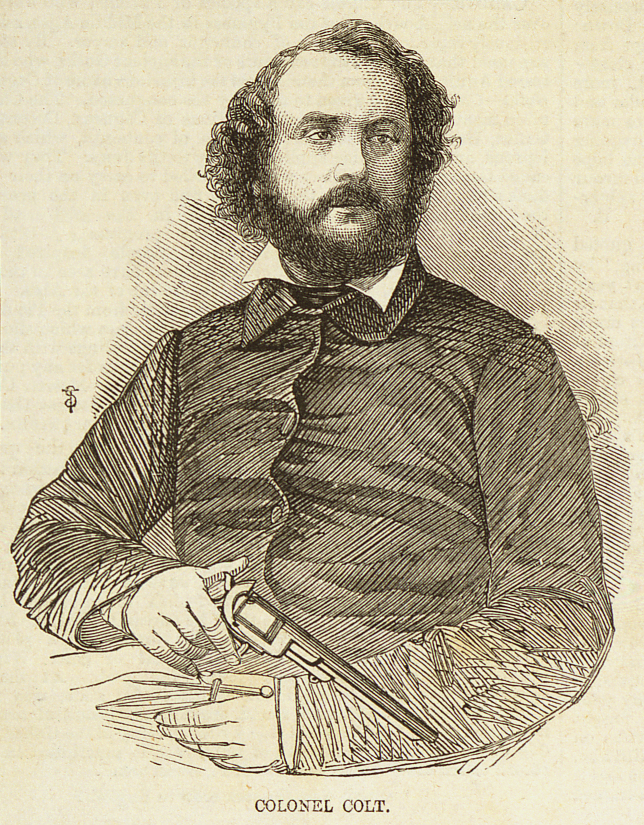
Public Domain: Library of Congress
Colt was born in Hartford, Connecticut on July 19, 1814 to Christopher Colt, a farmer and businessman, and Sarah Colt, who died of tuberculosis when Samuel was six years old.
Samuel's maternal grandfather, Maj. John Caldwell, was an officer in the Continental Army. One the first possessions Samuel ever called his own was, appropriately, Caldwell's flintlock pistol.
When Samuel was 11, he was indentured to a farmer in Glatsonbury, where he attended school. There he found the Compendium of Knowledge, which was a scientific encyclopedia of the day. He was particular fascinated with articles about gunpowder and the general idea of being an American inventor.
The Germination of an Idea
He learned to work with tools and various materials when he went to work in his father's Massachusetts textile plant in 1829 when he was 15 years old. Around that time he began experimenting with pyrotechnics and explosives.
On July 4, 1830, one of his experiments went wrong, causing a fire at his boarding school ,which ended his enrollment there. His father, likely angry, sent him off to become a seaman.
It was during a voyage to Calcutta that Samuel had the idea of a revolving firearm, inspired by the capstain, or windlass, with its ratchet and pawl mechanism.
Colt made a wooden model of his take on a pepperbox revolver, but it contained an important improvement over the pepperbox revolvers that already existed: the barrels would rotate automatically when the hammer was cocked. The hammer was attached to a pawl that turned the cylinder, which then locked in alignment with one of the barrels via a bolt. At the time, pepperbox "revolvers" required the barrels to be rotated by hand and there was no index or way to know for sure if the firing barrel was properly aligned.
In 1832, Samuel returned to the United States and to work for his father, who financed the production of two firearms for him, a rifle and a pistol. The first pistol he built exploded when it was test fired, but the long gun worked quite well.
Peddling Laughing Gas
With no more money coming from his father for research and development, a young Colt needed another source of income. He'd heard about the use of nitrous oxide (laughing gas) for various medical applications, and created an alternate persona, "the Celebrated Dr. Coult of New York, London, and Calcutta," and went on a tour, earning money giving laughing gas demonstrations all over the United States and Canada.
Colt thought of himself as a scientist, and it appears his enthusiasm for the use of nitrous oxide was genuine. Yet, he claimed to be a doctor when he was not and sort of leaned into the snake oil salesman side of things.
Colt gained a bit of fame when he did the pyrotechnics for a wax sculpture show created by Hiram Powers and based on Dante's "The Divine Comedy." The show included detailed wax sculptures and paintings of demons and other creatures from the classic literary work.
Back to Revolvers: The Colt Paterson
By this time, Colt was sick of the image he'd created and still yearned to be a respected inventor. He struck a deal to work with experienced gunsmiths in Baltimore and refined his revolving pepperbox idea, ditching the multiple barrels in favor of a design with a rotating, revolving cylinder instead with multiple chambers that aligned and indexed with the single barrel.
Colt got some money together for a prototype after he improved his design and filed for his first patents in 1835, wisely filing for foreign patents first in England and France, before securing a patent in the United States. Doing otherwise was prohibited.
His patent in America for a "revolving gun" was granted in February 1836, which protected the basic principles of his revolving, breech-loading, folding trigger firearm that later became known as the Colt Paterson revolver. Once Colt secured funding, the gun was made by the Patent Arms Manufacturing Company of Paterson, New Jersey, hence the name.
Instead of a trigger and trigger guard, the trigger was folded inside the frame until the hammer was cocked, which would simultaneously extend the trigger for firing.
Colt got a royalty for each five-shot Colt Paterson sold in exchange for the patent rights. The deal also allowed Colt to get the rights back if Patent Arms ever disbanded.
Did Colt Invent the Revolver?
Technically, Colt didn't invent the idea of a revolver, and he never claimed to have done so. Pepperbox revolvers included some important ideas and Collier's revolving flintlock shared some principles, which Colt combined once the introduction of the percussion cap and the reliable ignition source it provided made revolving firearms feasible.
Sam Colt's main contribution to firearm design at the time was the idea of interchangeable parts. It sounds crazy today to think that the same part on two machines of any kind built by the same company wouldn't be identical, but when parts were machined completely by hand on relatively primitive machinery before then being hand-fit together, the parts often varied quite a bit. Colt wanted all the parts of a gun to be made by machines, ensuring uniformity, to then be assembled by hand on an assembly line.
Colt's patent ensured his monopoly over revolvers until 1857 and the Colt Paterson proved to not only be the first practical revolver, but the first practical repeating firearm.
Despite the Paterson's innovation and success from a design perspective, they didn't sell well and Colt had to go on the road again to raise money to create the first gun with truly interchangeable parts.
Eventually, he traveled to Washington, D.C. and demonstrated the Paterson for President Andrew Jackson, who wrote Colt a letter commending the revolver. This allowed Colt to get Congress to endorse a military demonstration, though it ultimately didn't result in an order. He did secure an order for 75 Patersons for the state of South Carolina, but it was canceled when the company couldn't crank them out fast enough.
Furthermore, the Militia Act of 1808 stated that arms purchased by state militias had to be in current service with the U.S. military, so that ruled out a lot of potential sales. The Paterson was kept afloat after purchases by the state of Florida, which was fighting a war against the Seminoles. But in late 1843, the Paterson plant closed and its assets were liquidated.
A Break from Guns
While Samuel Colt is remembered for the guns he invented, that's not all he came up with. After the closure of the Paterson plant, Colt focused on underwater electrical detonators in underwater mines, and a waterproof cable he designed, which was made with tar-coated copper.
Colt partnered with Samuel Morse to lobby the government for funds for the cable, which he used to run telegraph lines under lakes, rivers, bays, and in an attempt to lay a telegraph line under the Atlantic Ocean.
When Colt's focus returned to firearms, it was on ammunition. With paper cartridges containing powder and ball becoming the standard, Colt was working on a tinfoil cartridge that he had originally designed for the Paterson revolver that would be far more waterproof than paper cartridges. They actually worked pretty well and produced less fouling.
After successful tests, the U.S. Army placed an order with Colt for 200,000 tinfoil cartridges, packed 10 to a box, for use in muskets.
Colt used the money from the deal to resume focus on his underwater telegraph cable and his partnership with Morse, which earned him enough money to try and resurrect Patent Arms. It didn't work out and he decided to work on improving his revolver design.
The Colt Walker
The prototype of Colt's improved revolver was built by a New York gunsmith. It included a stationary trigger and a larger bore than the Paterson.
Around the same time, Capt. Samuel Walker of the Texas Rangers acquired some of the Colt Paterson revolvers made for the Seminole War and saw how effective they were when issued to his 15-man unit, who used them to defeat a force of 70 Comanches in Texas.
He was so impressed that he wanted Patersons to become standard issue for all Rangers fighting in the Mexican-American War, and went looking for Samuel Colt in New York City.
The two met in a gunshop in January 1847 and Walker ordered 1,000 revolvers from Colt, stipulating a few changes to the design.
Walker wanted a six-shot cylinder instead of five. He also wanted the revolver to be powerful enough to kill a man or a horse with one shot. Walker also requested that the gun be easier to reload. To reload a Paterson revolver, it had to be partially disassembled.
Colt hired Eli Whitney Blake, already established in the firearms business, to actually make the guns while incorporating Walker's improvements to his new prototype. From that he was able to create the Colt Walker revolver.
The revolvers were quite large and were meant to be carried in holsters on a horse's saddle. An order for another thousand revolvers followed, with $10 per gun going to Colt.
With the money from the two orders and a load from his cousin, Colt bought the machinery and tooling from Blake and created Colt's Patent Firearms Manufacturing Company in Hartford, Connecticut. He also developed a carbine out of his revolver design, with mixed results.
The Colt Walkers were an improvement over previous designs, but they had issues. Some of the metallurgy used guns was questionable, and the cylinders had a tendency to rupture. Also, the lever for the ram rod was held in place by a weak mechanism. When it failed, the lever would fall under recoil, pushing the ramrod into a chamber from the front, and preventing the cylinder from rotating.
Colt made some tweaks and the first guns produced in Hartford were known as the Whitneyville-Hartford Dragoons, which mostly used leftover Walker parts. The Colt Dragoon models represent various improvements made over a number of years.
The powerful single action revolvers were used by both civilians and soldiers as major tools during westward expansion. In 1848, Colt introduced a smaller Baby Dragoon for civilians. In 1850, Gen. Sam Houston and Gen. Thomas Jefferson Rusk lobbied the Secretary of War and President James K. Polk to adopt Colt's guns for the United States military.
Colt created the 1851 Navy Revolver, which was between the Dragoon and Baby Dragoon in size, and it became the standard sidearm for United States military officers while also becoming popular on the civilian market.
To keep his guns affordable, he fixed the prices low and maximized sales volume, which also kept competing gunmakers at bay. However, he made a critical error when he dismissed an idea for a redesigned cylinder from one of his gunsmiths, Rollin White. The design would allow new metallic cartridges to be used in a revolver. After Colt's dismissal, White took the idea to Smith & Wesson, which patented the invention. Colt was therefore barred from building a metallic cartridge firearm for nearly 20 years.
In his later years, Colt gained a somewhat unsavory reputation for selling Colt firearms to both sides of conflicts in Europe. He did the same thing before and during the American Civil War. In 1859, Colt nearly built an armory in the South, and as late as 1861 sold 2,000 revolvers to Confederate agent John Forsyth, causing some newspapers to dub him a southern sympathizer and even a traitor to the Union.
Samuel Colt died from complications of gout in Hartford on Jan. 10, 1862. Colt's estate at the time of his death was valued at about $15,000,000 ($384,000,000 in 2019 dollars). Colt's brother-in-law, Richard Jarvis, took over the gun company.
The Colt Single Action Army Revolver
In its first 25 years of manufacturing, Colt's manufacturing company made over 400,000 handguns. However, the most famous Colt revolver, the Colt Single Action Army (SAA), also known as the M1873, Peacemaker, and Colt 45, wasn't produced until it was designed by Colt's Patent Firearms Manufacturing Company for U.S. government service revolver trials in 1872.
It served as the standard issue military service revolver until 1892. The revolver has become symbolic of the American West and has become an important piece of Americana. Some later, more modern versions are still available today.
It was largely the Colt name that allowed the SAA to beat out other similar designs, like the Remington 1875, at the time for the lucrative military contract. Also, Smith & Wesson's insistence on a cartridge war, which it lost, resulted in its Model 3 top-break revolver missing out on the huge contract.
All in all, Colt's firearms certainly left their impact on American history, and even though the most famous wasn't created until after his death, Samuel Colt influenced the way we fire guns, even to this day.
NEXT: RELOADING AN M1 ABRAMS TANK IS A STRESSFUL JOB
WATCH
